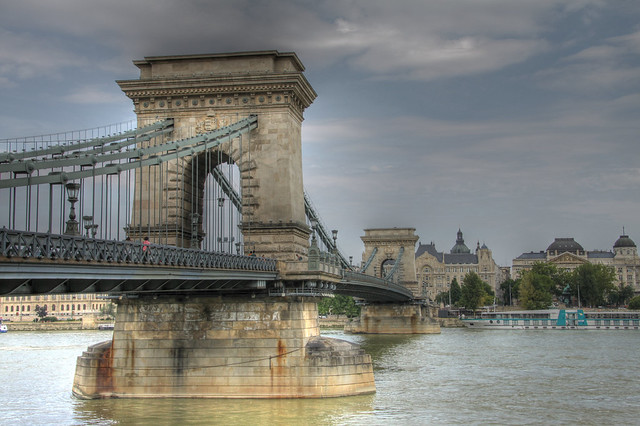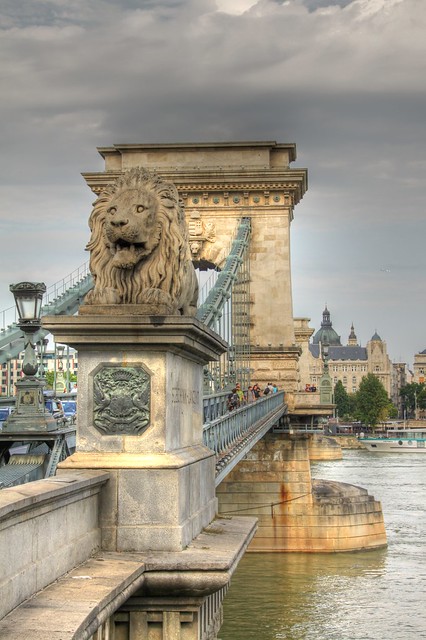

Στην Erzsébet-híd (Γέφυρα της Ελισάβετ)... Σκηνικό: ο Δούναβης, με την περίφημη Lánchíd (αλυσιδωτή γέφυρα), και το Κάστρο της Βούδας...
Το κορίτσι σταματάει στην γέφυρα να ανάψει ένα τσιγάρο... Ο νεαρός βγάζει ένα μικρό κόκκινο κουτάκι από την τσέπη του, το ανοίγει και γονατίζει... Η κοπέλα μένει άφωνη... Ο νεαρός σηκώνεται και η κοπέλα τον αγκαλιάζει και τον φιλάει... Υποθέτω αυτό σημαίνει "ναι"...
Μια ρομαντική σκηνή στην Βουδαπέστη...
Περίεργο σημείο επέλεξε, σκέφτηκα (η γέφυρα είναι μία από τις νεότερες της Βουδαπέστης)...
"Έκανε λάθος στην γέφυρα" διέκοψε την σκέψη μου η γυναίκα μου...
"Τι εννοείς;" την ρωτάω;
"Εσύ δεν μου είπες ότι η απέναντι γέφυρα είναι αυτή που ένωσε την Βούδα και την Πέστη σε μία πόλη, την Βουδαπέστη;"
"Ναι" της αποκρίνομαι
"Ε, αυτό είναι! Ήταν συμβολικό... Στην γέφυρα που ένωσε τις δύο πόλεις σε μία!!"
"Εεεε;"
"Μόνο που μάλλον έκανε λάθος στην γέφυρα ή μπορεί απλά να την ήθελε στο σκηνικό..."
Λέτε πραγματικά να έκανε λάθος;

Η Széchenyi lánchíd (Η αλυσιδωτή γέφυρα του Σέτσενι) εγκαινιάστηκε το 1849 και ήταν η πρώτη μόνιμη γέφυρα που ένωσε την Βούδα και την Πέστη. Χρηματοδότης της κατασκευής ήταν ο βαρώνος Γεώργιος Σίνας, γνωστός Έλληνας Εθνικός Ευεργέτης, ο οποίος θεωρείται ο πατέρας των σιδηροδρόμων στην Αυστρία και στα Βαλκάνια... Η γέφυρα καταστράφηκε όταν, κατά την αποχώρηση τους, κατά την διάρκεια του Δευτέρου Παγκοσμίου Πολέμου, οι Γερμανοί ανατίναξαν όλες τις γέφυρες της Βουδαπέστης... Ανακατασκευάστηκε το 1949.

Τα λιοντάρια πάνω στην γέφυρα είναι έργο του 1852.
Για την ιστορία της κατασκευής της Γέφυρας του Σέτσενι μπορείτε να διαβάσετε περισσότερα στο τεύχος 54 του περιοδικού Budapesti Negyed εδώ.
[ENG] On the Erzsébet Bridge... Background: Danube with its famous Széchenyi Chain Bridge and the Castle of Buda... The girl stops to light a cigarette and enjoy the view... The young guy takes out from his pocket a small red box, opens it and falls on his knees... The girl stays speechless... The guy gets up and the girl embraces and kisses him... Obviously, she meant "yes"... A romantic moment in Budapest... I was thinking why the guy had chosen this spot for his marriage proposal (the bridge is one of the newest in Budapest)... "He obviously made a mistake with this bridge!!" my wife interrupted my thoughts... "What do you mean?" I asked her. "Didn't you tell me that the next bridge is the one that connected Buda with Pest?", "Yes..." I replied. "It had to be symbolic... The bridge that connected two cities into one... now units two persons together...", "eeee?" and she continued "...but he was mistaken about which bridge it was the correct one or he wanted to have the correct bridge just in the background!". Do you think that this is actually what happened? The Széchenyi lánchíd or Széchenyi Chain Bridge is a suspension bridge that spans the river Danube between Buda and Pest, the western and eastern sides of Budapest, the capital of Hungary. It was the first permanent bridge across the Danube in Budapest, and was opened in 1849 [Info from Wikipedia]. The Bridge was financed by the Baron George Sina, of Greek origin who is considered the father of the railways in Austria and the Balkans... The pairs of lions at each of the abutments were added in 1852. During World War II, the bridge was damaged and needed to be rebuilt. The rebuilding was completed in 1949.








6 comments:
τα λιονταρια δεν εχουν γλωσσα !
ο αστικος μυθος θελει τον γλυπτη να αυτοκτονει με τα απο αυτο!!
yes, but it’s just a nice urban legend indeed… (although a widely believed one even in Hungary). If you go near and check it, you will see that all the four lions do have their tongue. :)
On György Sina / Γεώργιος Σίνας, a great mecenate of 19th-century Hungary (and also the founder of the Greek Academy in Athens!) you can find a good biography in Greek here, in the bilingual special edition of the urban history journal “Budapesti Negyed”, entirely dedicated to the Greeks in Budapest. It is worth to check the other articles as well, all in Hungarian and Greek.
As to the proposal and the bridge… Oxana is certainly right in that Chain Bridge would have been much more in style. And I certainly do not know what led the guy to choose exactly this bridge for this illustrious occasion. But as the Faculty of Letters is at the one end of Elizabeth Bridge and the National Library at the other, and thus thousands of students have to pass it daily, it can become the dearest bridge to many, as it was certainly to my wife and me who did so for five years before marrying…
Studiolum, I am glad you left the comment! Indeed it is only an urban myth... I checked it at my photo... In the biggest analysis there is clearly a tongue behind the teeth of the lion!
Regarding the bridge, do not say to me that you also proposed to your wife there!;
Well, even if the final, decisive gesture happened to happen elsewhere, I’m sure a good deal of the small daily proposals during those years that led to that big one did take place there… ;)
Είναι τόσο εντυπωσιακή η Βουδαπέστη όσο φαίνεται στις φωτογραφίες; Προσφέρεται για πολλές μέρες διαμονής; Να την ζήσεις και να την γευτείς;
Ναι, αν και εγώ δεν είχα την ευκαιρία να την δω πάνω από δύο μέρες, πιστεύω πως ναι!
Post a Comment